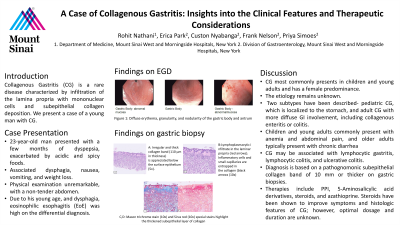Tuesday Poster Session
Category: Stomach
P4245 - A Case of Collagenous Gastritis: Insights into the Clinical Features and Therapeutic Considerations
Tuesday, October 24, 2023
10:30 AM - 4:00 PM PT
Location: Exhibit Hall

Has Audio

Rohit Nathani, MD
Mount Sinai Morningside and West Hospital
New York, New York
Presenting Author(s)
Rohit Nathani, MD1, Erica Park, MD2, Custon Nyabanga, MD3, Frank Nelson, MD2, Priya Simoes, MD2
1Mount Sinai Morningside and West Hospital, New York, NY; 2Mount Sinai Morningside and West, New York, NY; 3Mount Sinai Beth Israel, West and Morningside, New York, NY
Introduction: Collagenous Gastritis (CG) is a rare disease characterized by infiltration of the lamina propria with mononuclear cells and subepithelial collagen deposition. We present a case of a young man with CG.
Case Description/Methods: A 23 year old man presented with a few months of dyspepsia, exacerbated by acidic and spicy foods. He also reported associated dysphagia, nausea, vomiting, and weight loss. Physical examination was unremarkable, with a non-tender abdomen. Due to his young age, and dysphagia, eosinophilic esophagitis (EoE) was high on the differential diagnosis. The patient underwent esophagogastroduodenoscopy (EGD), revealing a normal esophagus but diffuse erythema, granularity, and nodularity of the gastric body and antrum (Picture 1). Biopsies from the esophagus were unremarkable. However, gastric biopsies revealed subepithelial collagen deposition on Trichrome and Sirius stains consistent with CG. Immunostaining for Helicobacter Pylori was negative. The patient was started on proton pump inhibitor (PPI) treatment and oral immediate-release budesonide for 8 weeks and is pending a repeat EGD to assess response.
Discussion: CG most commonly presents in children and young adults and has a female predominance. The etiology of CG remains unknown, and the disease has a varied clinical presentation depending on the age group. Two subtypes have been described- pediatric CG, which is localized to the stomach, and adult CG with more diffuse GI involvement, including collagenous enteritis or colitis. Children and young adults commonly present with anemia and abdominal pain, and older adults typically present with chronic diarrhea. Nausea, vomiting, weight loss, abdominal distension, and gastrointestinal bleeding are commonly associated symptoms. CG may be associated with lymphocytic gastritis, lymphocytic colitis, and ulcerative colitis.
Diagnosis is based on a pathognomonic subepithelial collagen band of 10 mm or thicker on gastric biopsies. Management of CG remains challenging due to the small number of cases and limited therapeutic options available. Therapies include PPI, 5-Aminosalicylic acid derivatives, steroids, and azathioprine. Steroids have been shown to improve symptoms and histologic features of CG; however, optimal dosage and duration are unknown. Our case adds to the limited literature on this rare condition.

Disclosures:
Rohit Nathani, MD1, Erica Park, MD2, Custon Nyabanga, MD3, Frank Nelson, MD2, Priya Simoes, MD2. P4245 - A Case of Collagenous Gastritis: Insights into the Clinical Features and Therapeutic Considerations, ACG 2023 Annual Scientific Meeting Abstracts. Vancouver, BC, Canada: American College of Gastroenterology.
1Mount Sinai Morningside and West Hospital, New York, NY; 2Mount Sinai Morningside and West, New York, NY; 3Mount Sinai Beth Israel, West and Morningside, New York, NY
Introduction: Collagenous Gastritis (CG) is a rare disease characterized by infiltration of the lamina propria with mononuclear cells and subepithelial collagen deposition. We present a case of a young man with CG.
Case Description/Methods: A 23 year old man presented with a few months of dyspepsia, exacerbated by acidic and spicy foods. He also reported associated dysphagia, nausea, vomiting, and weight loss. Physical examination was unremarkable, with a non-tender abdomen. Due to his young age, and dysphagia, eosinophilic esophagitis (EoE) was high on the differential diagnosis. The patient underwent esophagogastroduodenoscopy (EGD), revealing a normal esophagus but diffuse erythema, granularity, and nodularity of the gastric body and antrum (Picture 1). Biopsies from the esophagus were unremarkable. However, gastric biopsies revealed subepithelial collagen deposition on Trichrome and Sirius stains consistent with CG. Immunostaining for Helicobacter Pylori was negative. The patient was started on proton pump inhibitor (PPI) treatment and oral immediate-release budesonide for 8 weeks and is pending a repeat EGD to assess response.
Discussion: CG most commonly presents in children and young adults and has a female predominance. The etiology of CG remains unknown, and the disease has a varied clinical presentation depending on the age group. Two subtypes have been described- pediatric CG, which is localized to the stomach, and adult CG with more diffuse GI involvement, including collagenous enteritis or colitis. Children and young adults commonly present with anemia and abdominal pain, and older adults typically present with chronic diarrhea. Nausea, vomiting, weight loss, abdominal distension, and gastrointestinal bleeding are commonly associated symptoms. CG may be associated with lymphocytic gastritis, lymphocytic colitis, and ulcerative colitis.
Diagnosis is based on a pathognomonic subepithelial collagen band of 10 mm or thicker on gastric biopsies. Management of CG remains challenging due to the small number of cases and limited therapeutic options available. Therapies include PPI, 5-Aminosalicylic acid derivatives, steroids, and azathioprine. Steroids have been shown to improve symptoms and histologic features of CG; however, optimal dosage and duration are unknown. Our case adds to the limited literature on this rare condition.

Figure: Picture 1: Abnormal gastric mucosa with diffuse erythema, granularity, and nodularity of the gastric body and antrum on EGD
Disclosures:
Rohit Nathani indicated no relevant financial relationships.
Erica Park indicated no relevant financial relationships.
Custon Nyabanga indicated no relevant financial relationships.
Frank Nelson indicated no relevant financial relationships.
Priya Simoes indicated no relevant financial relationships.
Rohit Nathani, MD1, Erica Park, MD2, Custon Nyabanga, MD3, Frank Nelson, MD2, Priya Simoes, MD2. P4245 - A Case of Collagenous Gastritis: Insights into the Clinical Features and Therapeutic Considerations, ACG 2023 Annual Scientific Meeting Abstracts. Vancouver, BC, Canada: American College of Gastroenterology.
